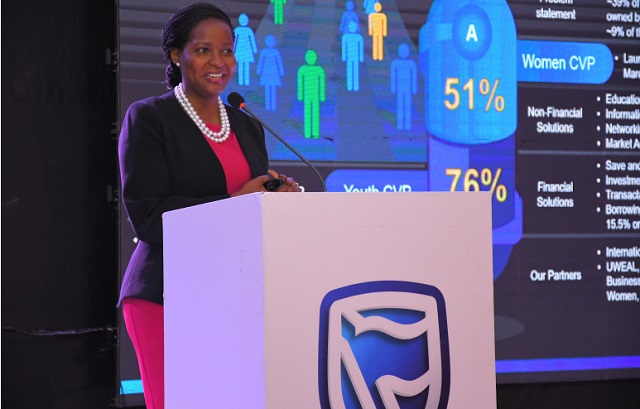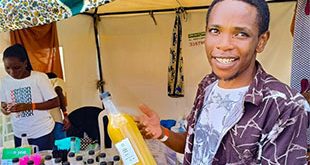
The lender recorded 11% growth in net profits to Shs269bn in 2021
Kampala, Uganda | ISAAC KHISA | Stanbic Uganda Holdings Ltd, a mother company for Stanbic Bank – one of the country’s oldest banks, which for nearly two decades served corporate clients, is now trying to remodel.
The country’s largest publicly listed lender not only wants to use technology to drive much of its business transactions but is also coming up with new products to manage competition and increase profitability.
Stanbic Chief Executive, Anne Jjuuko, said the bank now wants to do banking differently, stepping out of the box because it has always extended credit to salaried people, whose space is now filled up.
“We know that the customer we served 10 years ago and the one we are serving now have fundamentally changed. In the past, one would visit a branch manager, now one no longer needs to come to the bank,” she said while releasing the financial results in Kampala on March.30.
“In the past, one would write a loan application to the bank and wait for long, that has changed, the process is much faster now. We are in the age of urgency, age of immediacy and age of digital self-service. One can now get a Stanbic personal loan in under two minutes for the existing customer via our digital channels.”
Jjuuko revealed that Stanbic has started entering into partnerships and collaborations with various savings and credit cooperative societies, health workers, and developers of industrial parks among others.
Supporting SACCOs
Juuko said, the Sacco offering is at the heart of their financial inclusion agenda adding that the lender has come up with the Economic Enterprise Restart Fund where it sources loans at lower interest rates to SACCOs for onward lending to members at less than 12.5% per annum.
She said 150 SACCOs have so far received this funding impacting 220 beneficiaries since 2020.
“Our dream is that this fund will reach US$100million benefiting 10million Ugandans in the next five years,” she said.
Between August 2020 and December 2021, 150 SACCOs totaling a membership of 220,463 people, have shared in Shs18bn that was lent out to these savings groups. Benefits that go with the loans include financial management training, initiation to digitization and generous transactions terms for account holders.
In light of the economic disruptions caused by the Covid-19 pandemic, these funds offer a vital lifeline for the most vulnerable to financially recover and stabilize. Stanbic’s SACCO offering also complements the government’s roll-out of the Parish Development Model.
Buttressing SACCOs is particularly strategic. Members can borrow this money to improve agricultural production and productivity or embark on value-addition which translates into higher rural incomes.
The bank officially launched the SACCO proposition in February this year, starting with Eastern Uganda. Juuko, said “We are very excited to be going back to our roots of being the people’s bank. What we seek to do in this new SACCOs offering is to share our years of expertise and build capacity of the SACCOs to operate at the same level of excellence and in a modern manner. In addition to giving them loans at affordable interest, we will also train them to use our online platforms like Flexipay so that they can handle their finances better. They will also benefit from insurance packages that we are offering as a bank.”
The latest offering is intended to support SACCOs and VSLAs with accessible and affordable financing so they could lend to their members at a low interest rate but also build their digital capacity to serve their members better. Beneficiaries will be offered an opportunity to open a SACCO Account which features free cash and cheque deposits, free transfers into the account from members and free cash withdrawals.
Other benefits of the account include, free online banking, no monthly management fees, tiered interest paid on balances above Shs10million, financial literacy sessions for both management and selected members, as well as participation in capacity building programmes at the Stanbic Business Incubator.
Juuko added, “We are very excited to be going back to our roots of being the people’s bank. What we seek to do in this new SACCOs offering is to share our years of expertise and build capacity of the SACCOs to operate at the same level of excellence and in a modern manner.
In addition to giving them loans at affordable interest, we will also train them to use our online platforms like Flexipay so that they can handle their finances better. They will also benefit from insurance packages that we are offering as a bank.”
The state minister for Defence (General Duties) Jacob Oboth-Oboth said at the launch of the offering that SACCOs are one of the major avenues through which common Ugandans/farmers who are the majority of the country’s productive population can pull efforts together to address challenges that currently affect agriculture in Uganda.
“I believe in SACCOs. Many developed economies have gone through SACCOs, and if Stanbic Bank
and other financial institutions take this on, not as a way of making money but availing affordable
financing to the citizens at a grass root level, then we can finally achieve the highly needed social
and economic equality for all Ugandans’’ he said.
Lending to Industrial parks, other sectors
Jjuuko said the lender has extended Shs41billion to clients within the country’s industrial parks and working with various clients in Namanve, Kapeeka, Soroti,Mbale, Soroti and Luzira Industrial Parks. Motor cycle transporters popularly known as boda bodas, Kampala Capital City Authority and youths too have been brought to the loan access bracket.
“We will continue to serve the needs of large corporates and target several programmes that speaks to Ugandans at a lower segment of the population in order to make a difference.” Jjuuko said.
This, however, is bad news to Centenary and Post Bank that have capitalised on the lower customer segment for many years.
No dividends to shareholders again
Meanwhile, like the previous year, no dividends will be paid to shareholders in response to Bank of Uganda directive to preserve capital due to unpredictable COVID-19 situation, according to Juuko.
Stanbic Uganda recorded 11% growth in net profits for the 2021 to Shs 269billion compared to a year before, driven by strong growth in non-interest income.
The entity reported that non-interest revenue recorded a strong growth of 19.0% seeing earnings of Ushs401billion compared to the same period in the previous year. Much of the growth in the non-interest revenue was attributed to trading income which increased from Shs177.3billion to Shs233.7billion.
Net interest income for the year grew marginally by 1.5% to Ushs498bn citing slow growth in customer loans and lower margins as the country underwent a second lockdown in the middle of 2021.
Executives said, low economic activity in the year under review also informed low appetite in credit which saw marginal growth in the loan book from Shs3.6trillion in 2020 to Shs3.7trillion but maintained a 23.3% market share.
In relation to sector lending, the bank lent Shs290 billion to the trade sector, which is the second highest employer in Uganda, Shs225 billion to household lending, Shs 223bn to building and construction, Shs218 billion to manufacturing and Shs150bn to agriculture–the country’s highest employer.
Customer deposits grew by 5% from Shs5.4trillion to Shs5.7trillion in 2021 citing sustained customer brand loyalty and service experience through offering financial solutions that are appropriate for their needs.
Andrew Mashanda, Chief Executive SUHL that consists of SBG Securities Uganda Limited, Stanbic Business Incubator, Stanbic Properties Limited, and FlyHub Uganda said, like the previous year, 2021 was equally challenging especially during the first three quarters when the Covid-19 pandemic worsened, forcing the economy into another lengthy lockdown that affected several business activities countrywide.
“Notwithstanding these headwinds, Stanbic managed to post resilient results albeit slower growth in some areas. Our performance remains largely driven by the bank, but we are confident that the other subsidiaries will register good returns going forward,” he said.
Positive outlook
Jjuuko said with the economy now fully open after nearly two years of slow activity due to the pandemic—they are upbeat and ready to support full economic recovery.
“We shall continue to innovate for the customer and avail digitally disbursed affordable credit through bespoke products for women, youth, farmers and our corporate customers,” she said.
****
 The Independent Uganda: You get the Truth we Pay the Price
The Independent Uganda: You get the Truth we Pay the Price





